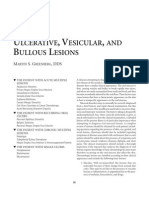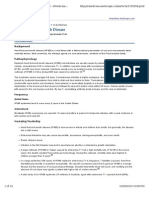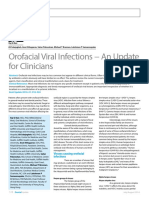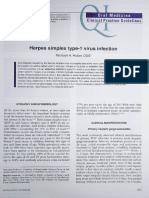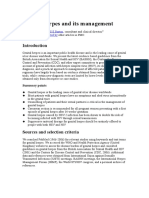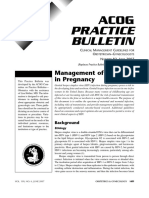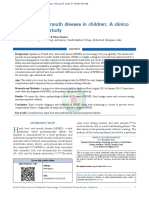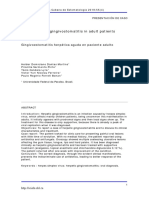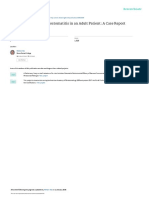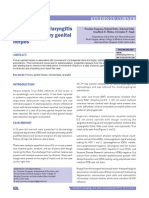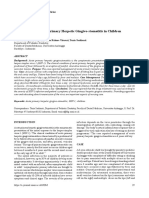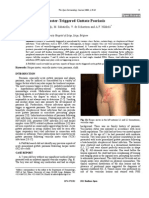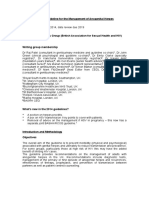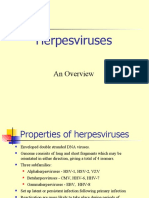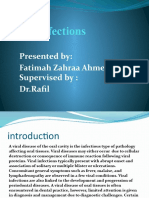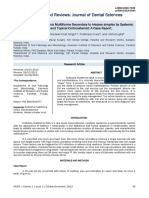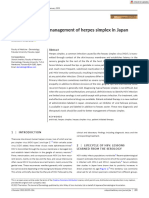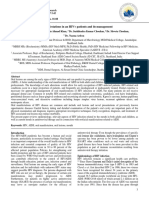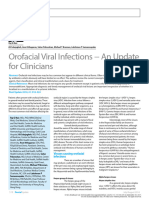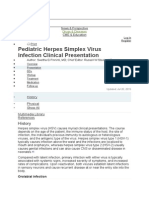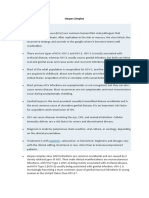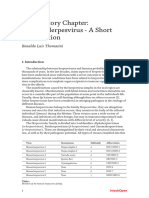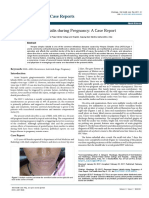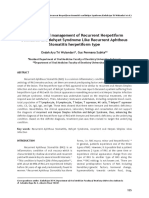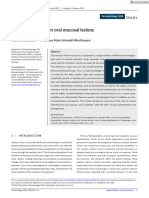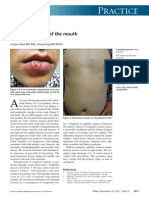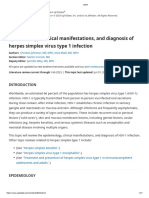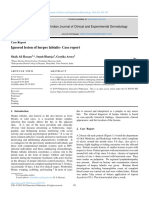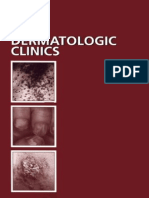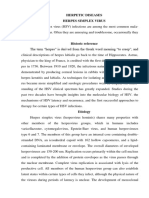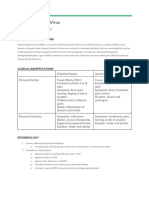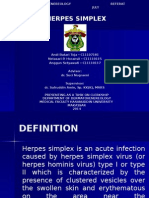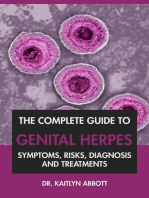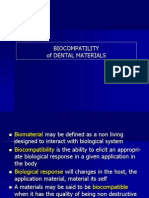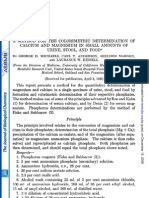Acute Herpetic Gingivostomatitis in Adults: A Review of 13 Cases, Including Diagnosis and Management
Acute Herpetic Gingivostomatitis in Adults: A Review of 13 Cases, Including Diagnosis and Management
Uploaded by
Afaf MahmoudCopyright:
Available Formats
Acute Herpetic Gingivostomatitis in Adults: A Review of 13 Cases, Including Diagnosis and Management
Acute Herpetic Gingivostomatitis in Adults: A Review of 13 Cases, Including Diagnosis and Management
Uploaded by
Afaf MahmoudOriginal Title
Copyright
Available Formats
Share this document
Did you find this document useful?
Is this content inappropriate?
Copyright:
Available Formats
Acute Herpetic Gingivostomatitis in Adults: A Review of 13 Cases, Including Diagnosis and Management
Acute Herpetic Gingivostomatitis in Adults: A Review of 13 Cases, Including Diagnosis and Management
Uploaded by
Afaf MahmoudCopyright:
Available Formats
C
L I N I C A L
R A C T I C E
Acute Herpetic Gingivostomatitis in Adults: A Review of 13 Cases, Including Diagnosis and Management
Amir H. Ajar, BSc, DDS Peter J. Chauvin, DDS, MSc, FRCD(C)
A b s t r a c t
Objective: To present to general dentists the typical signs and symptoms associated with adult acute (primary) herpetic gingivostomatitis. The pertinent laboratory tests, management options and current pharmacotherapy are also reviewed. Review Design: The clinical les of 13 adult patients were reviewed. All had no history of herpes simplex virus infection and presented with oral lesions suggestive of primary herpetic infection. The subjects were all patients of one of the investigators, and their workup included Tzanck testing and viral culture. Results: The patients ranged in age from 18 to 79 (mean 37.2, standard deviation 19.6) years. Nine (69%) were men. Viral culture was conrmed as the gold standard for diagnosis. The sensitivity of Tzanck testing was 77% (10/13), slightly higher than that reported previously (40% to 50%). In this patient group the febrile lymphadenopathic prole was typical of younger patients (18 to 42 years of age), whereas older patients presented with predominantly oral symptoms. Conclusions: Primary herpetic gingivostomatitis is not limited to children but can affect people of any age. Proper diagnosis and treatment are essential, particularly in elderly and immunocompromised patients. Tzanck testing may serve as a useful adjunct in diagnosis. Antiviral agents such as valacyclovir and famciclovir should be considered part of early management. Dentists are often the rst health care professionals to be consulted by patients with this condition, and recognition of the infection is paramount. MeSH Key Words: adult; stomatitis, herpetic/diagnosis; stomatitis, herpetic/therapy
J Can Dent Assoc 2002; 68(4):247-51 This article has been peer reviewed.
cute (primary) herpetic gingivostomatitis (AHGS) typically affects children, but this infection also occurs in adults. Because of the limited symptoms, a dentist may be the rst health care practitioner consulted. It is therefore important that dentists be able to recognize the condition (Fig. 1). The causative agent for AHGS has been identied as herpes simplex virus (HSV). HSV is a double-stranded DNA virus and is a member of the human herpes virus (HHV) family officially knows as Herpetoviridae.1 The virus exists in 2 forms, HSV-1 (or HHV-1) and HSV-2 (or HHV-2). Most oral, facial and ocular infections result from HSV-1, whereas HSV-2 accounts for most genital and cutaneous lower body herpetic lesions. Orogenital contact may
Journal of the Canadian Dental Association
allow either serotype to cause oral or genital lesions. The 2 forms of HSV have similar structure but differ in antigenicity, although HSV-2 is reputed to be of greater virulence. Other members of this group include varicella-zoster virus (VZV, which causes chickenpox and shingles) or HHV-3, EpsteinBarr virus (EBV) or HHV-4, Cytomegalovirus (CMV) or HHV-5 and 3 recent additions known simply as HHV-6, HHV-7 and HHV-8.2 The sites most at risk for HSV infection are the skin, eyes, mucous membranes and central nervous system. HSV is short-lived on external surfaces; infection therefore depends on intimate contact with an individual who is shedding live virus through secretions, saliva or skin.3 In addition, the virus must come into contact with a break in the integrity of
April 2002, Vol. 68, No. 4
247
Ajar, Chauvin
Figure 1: Thirty-six-year-old man with gingival erythema, multiple small ulcers and vesicles in the attached gingiva, which are typical symptoms of acute herpetic gingivostomatitis.
Figure 2: Herpetic whitlow with vesicular skin eruption in a 21-yearold female dental student.
the mucosa or skin of a susceptible host. Even microscopic breaks are susceptible, so skin and mucous membranes with normal appearance may be at risk (Fig. 2). The age at onset of AHGS has been reported to have 2 peaks. The main one is during childhood, usually between the ages of 6 months and 5 years, and the second peak occurs in the early 20s.1 Most primary HSV infections in children are either asymptomatic or so mild that the child or parent does not notice. Some studies suggest only 10% to 12% of children who are infected have signs or symptoms severe enough to be remembered.1 The severity of signs and symptoms may be attributable to the virulence of the specic strain of HSV and the hosts immune response. Once HSV penetrates the hosts epithelial cells, viral replication occurs. The newly formed HSV come into contact with sensory nerve endings and are transported to the corresponding ganglion.2 In oral labial herpes, the most common site is the trigeminal ganglion. Here the viral DNA enters the ganglion, where it becomes inactive or latent. The incubation period is the period during which viral replication and transport to the sensory ganglion occur. For HSV, this period is variable and can range from a few days to 3 weeks, but in most cases it is approximately 1 week. The severity of the primary infection depends on the degree of viral replication, the hosts response to the foreign pathogen and the speed with which latency is established. Asymptomatic primary infections are thought to occur in cases in which HSV causes minimal epithelial cell destruction through replication. In these cases, the newly formed virions enter the sensory axons and become latent in the ganglion. These cases of HSV will have minimal to no manifestations. However, if these virions infect adjacent epithelial cells and continue to cause cell lysis, in conjunction with the inammatory response mediated by the host immune system, the primary infection is clinically evident and symptomatic.4 Recurrence is highly variable and can occur in response
248
April 2002, Vol. 68, No. 4
to exposure to ultraviolet light, stress, fever, cold, pregnancy or menstruation, gastrointestinal upset or local trauma.1,2 The variability of HSV recurrence depends on previous seroconversion, general immunological status and exposure to the aforementioned situations. In terms of previous seroconversion, patients who have been exposed to another form of herpes (for example, genital, ocular or herpetic whitlow) tend to experience a milder clinical course than seronegative patients. In addition, the adult course of primary AHGS is longer and characterized by more severe symptoms than AHGS in children. It is important to distinguish primary from recurrent herpetic infection. In general terms, a primary infection is more severe, with associated lymphadenopathy, fever and malaise. Recurrent infections occur at various intervals (ranging from monthly in some individuals to seldom in others) and affect the non-movable intraoral tissues (the hard palate and attached gingiva), in contrast to primary herpes which can occur anywhere in the mouth.1 History may be helpful in distinguishing primary from secondary infection, as patients with a secondary infection will recall previous episodes of vesicular eruptions on their lips, thus eliminating the possibility of primary AHGS. In this article we review a series of adult cases of AHGS to demonstrate the typical features of this viral infection. The diagnostic aids available for detection, as well as the treatment options, are also reviewed.
Case Selection and Description of Methods
The clinical les of one of the authors (PJC) for a 5-year period (1993 to 1998) at the Montreal General Hospital were reviewed for cases suggestive of acute viral infection precipitated by HSV. We reviewed all adult cases of acute HSV infection conrmed by viral culture. A single clinician investigator (PJC) performed all Tzanck testing and viral culture.
Journal of the Canadian Dental Association
Acute Herpetic Gingivostomatitis in Adults: A Review of 13 Cases
Figure 3: Gingival hyperplasia, erythema and ulceration, typical symptoms of acute herpetic gingivostomatitis, in a 30-year-old woman.
Figure 4: Twenty-four-year-old man with intact vesicles.
Figure 5: Same patient as in Fig. 4 after preparation of Tzanck smear. Unroofed vesicles are now exposed.
Thirteen patients were identied, 9 men and 4 women, ranging in age from 18 to 79 (mean 37.2, standard deviation 19.6) years. The patients were typically referred by their general dentist with signs and symptoms of widespread oral ulcers (tongue, gingiva and palate), gingivitis, cervical lymphadenopathy, fever and malaise (Fig. 3). The minimum criteria for inclusion in the review were negative history of primary or recurrent orofacial herpes, widespread bilateral oral vesicles or ulcers affecting the gingiva and mobile mucous membranes, and conrmation of the presence of HSV by viral culture. At the time of clinical presentation, a Tzanck smear and sample for viral culture were obtained. The result of Tzanck testing was positive in 10 of the 13 cases (sensitivity 77%). The culture result was positive in all 13 cases.
Laboratory Techniques
Although AHGS is diagnosed mainly on the basis of absence of any previous clinical history, coupled with hallmark clinical signs and symptoms, several laboratory techJournal of the Canadian Dental Association
niques are available for detecting herpetic infections. These can be classied under 6 main headings: morphologic, immunomorphologic, serologic, virologic, immunovirologic and molecular virologic.5 In dentistry, the most practical techniques are either Tzanck testing (morphologic), viral culture or direct immunouorescence (immunomorphologic). The Tzanck test is a cytological technique that involves unroong the early viral vesicle (not the pustule or ulcer) and scraping the viral lesion gently with a tongue blade or scalpel (Figs. 4 and 5). The sampled material is then placed on a glass slide and stained. The presence of multinucleated epithelial giant cells is consistent with a herpes virus infection. This method generally detects only about 60% of HSV infections, although one study suggested a much lower rate of detection (40% to 50%).5 Smears also yield no information as to whether the viral agent is HSV-1, HSV-2 or VZV. The relatively low percentage of positive results obtained with this method can be attributed to difficulty in interpreting the specimens and degree of interpreter experience, and smears taken from lesions developing later in the infection will generally be negative.5 Nonetheless, this method is an inexpensive in-office technique and can usually conrm suspicions of AHGS. Viral culture is considered the gold standard and the most sensitive of the diagnostic techniques. It requires the culturing of live virus, with maintenance of an environment suitable for viral growth (the viral medium), free from bacterial or fungal contamination.5 Unsuitable conditions for transport of tissue intended for culture result in viral death and false-negative results. The test is sensitive to technique and is generally limited to the hospital setting, where equipment and facilities exist for storage and examination of the culture. Direct immunouorescence techniques, which require special equipment (a uorescence microscope), are likewise
April 2002, Vol. 68, No. 4
249
Ajar, Chauvin
restricted to the hospital setting. These methods can differentiate between the members of the herpes virus family. The technique is rapid, but considerable experience is required for interpretation. Smears are submitted fresh on special slides.
Laboratory Findings
In this study, several interesting points came to light. The sensitivity of Tzanck testing was 77%, much higher than the 40% to 50% previously reported.5 This high level of sensitivity may be attributable to the smears having been taken at an earlier stage in the clinical presentation. All of the patients exhibited all or most of the classic signs and symptoms of AHGS, namely fever, lymphadenopathy, malaise, gingivitis, intraoral pain and, ultimately, oral ulcerations. However, it is of note that the febrile, lymphadenopathic prole t only the younger patients (those aged 18 to 42 years) afflicted with this condition. In contrast, the patients over 60 years of age did not have lymphadenopathy, and only one of them presented with fever. There were no peculiarities in location of vesicular eruption that could be attributed to age or sex. The most frequent sites involved were the tongue and gingiva; the palate and buccal mucosa were also affected, but not as often. Certain authors have reported that adult AHGS presents more often as a form of pharyngotonsillitis.1 This was not our experience, and only one patient presented with symptoms suggestive of this course. However, it is difficult to draw any conclusions from this observation, as it is our suspicion that patients presenting with pharyngotonsillitis are more likely to consult a physician than a dentist. It is nonetheless important to note that AHGS may present in this manner. In this sample more men than women were affected (9/13 or 69%). This nding contrasts with the HSV-2 results obtained by Langenberg and others 6 and Wald,7 who found that women were more likely to acquire HSV-2 and to be symptomatic. Our results may suggest that if more women are seroconconverting to HSV-2, then they will have some, though perhaps not complete, protection against HSV-1. As a result, more men will appear HSV-1 positive. While there may indeed be a second peak in age of onset, in the early 20s, our results indicate that this infection can occur at any age: 8 (62%) of the 13 patients were over the age of 30, and the oldest was 79 years of age. It is possible that some of the cases included here as primary herpetic gingivostomatitis actually represented a severe form of recurrent intraoral herpes that had spread to affect other sites. The term acute herpetic gingivostomatitis is therefore more appropriate than primary herpetic gingivostomatitis.
Management and Pharmacotherapy
Although adult AHGS usually runs a benign, selflimiting course in immunocompetent patients, adjunctive measures may be undertaken to minimize the severity of
250
April 2002, Vol. 68, No. 4
symptoms. Such measures are especially useful in adults, since the infection tends to run a longer, more severe course in adults than in children. Diagnosis is based on the clinical features, namely fever, malaise, cervical lymphadenopathy, marginal gingivitis, gingival hyperplasia, a negative history of herpes labialis and oral ulcerations in either the gingiva or the palate (or both). In the immunocompromised patient, prompt recognition and treatment are crucial, as these patients have a high risk for disseminated viral infection with signicant morbidity. Tzanck testing is an easy, inexpensive technique to conrm suspicion of AHGS, and it has the added advantage that it can be performed in the office. The reported sensitivity is 40% to 50%, depending on interpreter experience and degree of maturation of the viral vesicle (pustules or ulcers tend to yield lower sensitivities). When in doubt, patients can be referred to hospital for viral culture or direct immunouorescence, although such referral must be done soon after presentation, because of the self-limiting course of AHGS. If gingival hyperplasia is present without oral vesicles or ulcers, the workup should include routine blood testing (complete blood count with differential count and peripheral blood smear) to rule out any abnormalities suggestive of leukemia. Conventional antiviral therapy associated with oral HSV has been acyclovir (in either cream or oral form). However, because of its poor gastrointestinal absorption and bioavailability, acyclovir has not routinely been used in the management of AHGS except for the oral suspension administered in a rinse and swallow technique.1 Valacyclovir and famciclovir are 2 more recently developed antiviral agents that may be used in the treatment of AHGS. Valacyclovir is an altered form of acyclovir, which acts by increasing, by 3 to 5 times, the bioavailability of acyclovir (to which it is converted via hepatic metabolism).8 It is well tolerated in healthy patients and is prescribed in doses of 1 g tid for 7 days for herpes zoster, although 1 g bid should be effective for AHGS. Famciclovir, the oral prodrug of penciclovir, has an oral bioavailability 3 to 5 times that of acyclovir. Both penciclovir and acyclovir function through competitive inhibition of viral DNA synthesis by means of selective phosphorylation by viral thymidine kinase. Although acyclovir is a more potent inhibitor of viral DNA polymerase, the advantage of penciclovir and its analogues is that it is present in infected cells at much higher concentrations and for longer periods than acyclovir and its analogues.9 Penciclovir is marketed only in the United States, in a topical form (cream). However, famciclovir is available in Canada and has been successfully used by the authors of this review. The dosage of famciclovir recommended for treatment of herpes zoster is 500 mg tid po for 7 days, although 500 mg bid was effective in AHGS. A signicant
Journal of the Canadian Dental Association
Acute Herpetic Gingivostomatitis in Adults: A Review of 13 Cases
acceleration in clinical resolution can be seen with the use of anti-viral therapy. The earlier these medications are given, the more effective they are. They do not affect dormant virus protected in nerve ganglions and therefore will not eliminate the virus completely. After treatment of a primary infection a patient may still experience episodes of recurrent herpes labialis if the virus becomes reactivated. The severity and quantity of intraoral lesions may significantly reduce dietary intake and predispose the patient to dehydration. Thus, it is important to balance any decrease in intake with uids. Either nutritional supplements or a pureed or blended diet is sufficient until the patient can tolerate solids. Most systemic analgesics such as acetaminophen are adequate to manage the associated pain and malaise. A palliative mouth rinse made by mixing attapulgite (Kaopectate, Johnson & Johnson Merck, Guelph, Ontario) with diphenhydramine (Benadryl Elixir, Pzer, Toronto, Ontario) (50:50 by volume) may also be helpful. Acute forms of HSV infection pose a high risk for transmission. This potential is of particular interest to noninfected dental professionals who risk occupational exposure to oral herpes, herpetic whitlow of the digits and ocular herpes. For this reason, gloves and safety glasses must be used during the examination, especially given that the risk of asymptomatic shedding is omnipresent. Patients should also be advised to minimize intimate contact when active lesions are present, as they are at risk of spreading the virus.
mellitus and kidney disease. Likewise, acumen in the detection of AHGS, while generally of reassuring and symptomatic benet in immunocompetent patients, can be life saving in immunocompromised or immunosuppressed patients (transplant recipients and those with human immunodeciency virus). C
Dr. Ajar is in practice in Calgary, Alberta. Dr. Chauvin is director, division of oral pathology, faculty of dentistry, McGill University, Montreal, Quebec. Correspondence to: Dr. Peter Chauvin, Department of Pathology, Room D3-225, Montreal General Hospital, 1650 Cedar Ave., Montreal, QC H3G 1A4. E-mail: peter.chauvin@muhc.mcgill.ca. The authors have no declared nancial interests in any company manufacturing the types of products mentioned in this article.
References
1. Neville, BW, Damm DD, Allen CM, Bouqout JE. Viral infections. In: Neville, BW, Damm DD, Allen CM, Bouqout JE. Oral and Maxillofacial Pathology. 2nd ed. Philadelphia: WB Saunders Co.; 2002. p. 213-20. 2. Chandrasekar PH. Identication and treatment of herpes lesions. Adv Wound Care 1999; 12(5):254-62. 3. Whallett EJ, Pahor AL. Herpes and the head and neck: the difficulties in diagnosis. J Laryngol Otol 1999; 113(6):573-7. 4. Stanberry LR, Cunningham AL, Mindel A, Scott LL, Spruance SL, Aoki FY, and others. Prospects for control of herpes simplex virus disease through immunization. Clin Infect Dis 2000; 30(3):549-66. 5. Cohen PR. Tests for detecting herpes simplex virus and varicella-zoster virus infections. Dermatol Clin 1994; 12(1):51-68. 6. Langenberg AG, Corey L, Ashley RL, Leong WP, Straus SE. A prospective study of new infections with herpes simplex virus type 1 and type 2. Chiron HSV Vaccine Study Group. N Engl J Med 1999; 341(19):1432-8. 7. Wald A. Herpes. Transmission and viral shedding. Dermatol Clin 1998; 16(4):795-7. 8. Bell AR. Valaciclovir update. Adv Exp Med Biol 1999; 458:149-57. 9. Sacks SL, Wilson B. Famciclovir/penciclovir. Adv Exp Med Biol 1999; 458:135-48.
Conclusions
Primary oral herpetic infections are not limited to children but can occur at any age. The recognition of the classic presentation of signs and symptoms is important, particularly in middle-aged and elderly people, in whom the superimposition of dehydration due to AHGS can complicate pre-existing medical conditions such as diabetes
Journal of the Canadian Dental Association
April 2002, Vol. 68, No. 4
251
You might also like
- Chapter 4 Notes Igcse Edexcel BiologyDocument10 pagesChapter 4 Notes Igcse Edexcel Biologyjhjsxwchk50% (1)
- Hi Solid PolyurethaneDocument4 pagesHi Solid PolyurethaneafvasquezNo ratings yet
- Ch04oral MedicineDocument35 pagesCh04oral MedicineNaleena JosephNo ratings yet
- Hand Foot and Mouth DiseaseDocument14 pagesHand Foot and Mouth DiseaseE=MC2No ratings yet
- Primary Herpetic GingivostomatitisDocument5 pagesPrimary Herpetic GingivostomatitisGaleri Kreasi SepatukuNo ratings yet
- Orofacial Viral Infections An UpdateDocument6 pagesOrofacial Viral Infections An UpdateAli RazaNo ratings yet
- Oral Viral Infections Diagnosis and ManagementDocument13 pagesOral Viral Infections Diagnosis and ManagementhunarsandhuNo ratings yet
- Biopsy TechniquesDocument31 pagesBiopsy Techniqueschouchou124No ratings yet
- 3 Focal Infection of Periodontal Origin 2019Document3 pages3 Focal Infection of Periodontal Origin 2019fhiraNo ratings yet
- Gittle R 2017Document4 pagesGittle R 2017Hari 'hardyboy' PurwantoNo ratings yet
- Journal of Advanced Medical and Dental Sciences ResearchDocument3 pagesJournal of Advanced Medical and Dental Sciences ResearchBrili AnenoNo ratings yet
- Herpes Simplex Type-1 Virus Infection (2003)Document16 pagesHerpes Simplex Type-1 Virus Infection (2003)Aron RonalNo ratings yet
- Treatmnt HerpesDocument8 pagesTreatmnt HerpesZakky FebrianNo ratings yet
- Oral Viral Infections Diagnosis and Management PDFDocument13 pagesOral Viral Infections Diagnosis and Management PDFWesley Rodrigues100% (1)
- Genital Herpes and Its ManagementDocument12 pagesGenital Herpes and Its ManagementpriscillaNo ratings yet
- Herpes SimplexDocument27 pagesHerpes SimplexHania KhanNo ratings yet
- ACOG Practice Bulletin No 82 Management Of.50Document10 pagesACOG Practice Bulletin No 82 Management Of.50Ccorita GuerraNo ratings yet
- Hand, Foot and Mouth Disease in Children: A Clinico Epidemiological StudyDocument6 pagesHand, Foot and Mouth Disease in Children: A Clinico Epidemiological Studysamy22722No ratings yet
- Acute Herpetic Gingivostomatitis in Adult Patients: Gingivoestomatitis Herpética Aguda en Paciente AdultoDocument6 pagesAcute Herpetic Gingivostomatitis in Adult Patients: Gingivoestomatitis Herpética Aguda en Paciente AdultoBrili AnenoNo ratings yet
- 33HSVRamaDocument5 pages33HSVRamaPriskilla RachmiyantiNo ratings yet
- Herpes Simplex Laryngitis Following Primary Genital Herpes: Students' CornerDocument4 pagesHerpes Simplex Laryngitis Following Primary Genital Herpes: Students' CornerEpi PanjaitanNo ratings yet
- HSV Notes 2014Document37 pagesHSV Notes 2014Juan Manuel JorqueraNo ratings yet
- Management of Acute Primary Herpetic Gingivo-Stomatitis in ChildrenDocument3 pagesManagement of Acute Primary Herpetic Gingivo-Stomatitis in ChildrenNindy PutriNo ratings yet
- Herpes Simplex VirusesDocument17 pagesHerpes Simplex VirusesДенніс МонгатеNo ratings yet
- Herpes ZosterDocument4 pagesHerpes ZosterSeptiandry Ade PutraNo ratings yet
- HSV Final Guidelines With Ref SortedDocument22 pagesHSV Final Guidelines With Ref SortedScOta Adoncia RaekanafEezaNo ratings yet
- Viral Infections of The Oral CavityDocument33 pagesViral Infections of The Oral CavityChukwuenyem BlessingNo ratings yet
- Herpes VirusesDocument71 pagesHerpes VirusesAyioKunNo ratings yet
- Viral Infections: Presented By: Fatimah Zahraa Ahmed Supervised By: DR - RafilDocument31 pagesViral Infections: Presented By: Fatimah Zahraa Ahmed Supervised By: DR - Rafilfatimah zahraaNo ratings yet
- Research and Reviews: Journal of Dental SciencesDocument5 pagesResearch and Reviews: Journal of Dental Sciencesjenn_1228No ratings yet
- Otolaryngologic Manifestations of HIV Infection: ReviewsDocument6 pagesOtolaryngologic Manifestations of HIV Infection: ReviewsSo NicNo ratings yet
- The Journal of Dermatology - 2023 - Imafuku - Recent Advance in Management of Herpes Simplex in JapanDocument6 pagesThe Journal of Dermatology - 2023 - Imafuku - Recent Advance in Management of Herpes Simplex in Japanisadoramac04No ratings yet
- Ep 3Document10 pagesEp 3Mădălina ŞerbanNo ratings yet
- Oral Manifestations in An HIV+ Patients and Its ManagementDocument8 pagesOral Manifestations in An HIV+ Patients and Its ManagementAnye PutriNo ratings yet
- Virals - 1Document6 pagesVirals - 1rajesh kumarNo ratings yet
- Pediatric Herpes Simplex Virus Infection Clinical PresentationDocument7 pagesPediatric Herpes Simplex Virus Infection Clinical PresentationAnnyKusumadewiAkbarNo ratings yet
- Herpes SimplexDocument30 pagesHerpes Simplexketty putriNo ratings yet
- Luisthomasini 2020Document6 pagesLuisthomasini 2020Dyah Wahyu Oktania SariNo ratings yet
- Herpes Labialis During PregnancyDocument3 pagesHerpes Labialis During Pregnancyhendra cahyaditaNo ratings yet
- Infection Control LecturDocument62 pagesInfection Control LecturMoona WahabNo ratings yet
- Diagnosis and Management of Recurrent Herpetiform Stomatitis and Behçet Syndrome Like Recurrent Aphthous Stomatitis Herpetiform TypeDocument8 pagesDiagnosis and Management of Recurrent Herpetiform Stomatitis and Behçet Syndrome Like Recurrent Aphthous Stomatitis Herpetiform TypeFahmil AgungNo ratings yet
- Periodontology 2000 - 2024 - Dommisch - The Role of Viruses in Oral Mucosal LesionsDocument14 pagesPeriodontology 2000 - 2024 - Dommisch - The Role of Viruses in Oral Mucosal LesionsHosuru SwethaNo ratings yet
- Erythema Multiforme Major in Hiv Patient: Nur CameliaDocument5 pagesErythema Multiforme Major in Hiv Patient: Nur CameliaNur CameliaNo ratings yet
- Practice: Syphilitic Chancre of The MouthDocument1 pagePractice: Syphilitic Chancre of The MouthAlfonsius JeriNo ratings yet
- Epidemiology, Clinical Manifestations, and Diagnosis of Herpes Simplex Virus Type 1 InfectionDocument41 pagesEpidemiology, Clinical Manifestations, and Diagnosis of Herpes Simplex Virus Type 1 InfectionAdrianaIDCNo ratings yet
- NEJM 347 p0340Document7 pagesNEJM 347 p0340Nantini GopalNo ratings yet
- Chronic Virus Report of Three Cases Indolent Orofacial Herpes Simplex Infection in Chronic Leukemia: ADocument4 pagesChronic Virus Report of Three Cases Indolent Orofacial Herpes Simplex Infection in Chronic Leukemia: ANatalia RafaelNo ratings yet
- Jurna Herpes Labialis 3Document3 pagesJurna Herpes Labialis 3Tifani Cita DewiNo ratings yet
- Oral Mucosal Changes Associated With FluDocument4 pagesOral Mucosal Changes Associated With FluManar AlsoltanNo ratings yet
- 2002, Vol.20, Issues 2, VirologyDocument165 pages2002, Vol.20, Issues 2, VirologyRizweta DestinNo ratings yet
- Herpetic DiseasesDocument18 pagesHerpetic DiseasesKrishna VadodariyaNo ratings yet
- Herpes Simplex Virus Handout PDFDocument3 pagesHerpes Simplex Virus Handout PDFdemeNo ratings yet
- (ANDREWS) Herpes, Varicella, Shingles PDFDocument19 pages(ANDREWS) Herpes, Varicella, Shingles PDFmpsoletaNo ratings yet
- Herpes SimplexDocument24 pagesHerpes Simplexaybatari0% (1)
- HTTPS:WWW Ncbi NLM Nih gov:pmc:articles:PMC9867007:pdf:viruses-15-00225Document17 pagesHTTPS:WWW Ncbi NLM Nih gov:pmc:articles:PMC9867007:pdf:viruses-15-00225Don SarNo ratings yet
- 1 PBDocument12 pages1 PBMelvin RismaNo ratings yet
- Neonatalherpessimplex Virusinfection: Scott H. James,, David W. KimberlinDocument10 pagesNeonatalherpessimplex Virusinfection: Scott H. James,, David W. KimberlinTais LineNo ratings yet
- Comprehensive Insights into Herpes Simplex: From Virology to Holistic ManagementFrom EverandComprehensive Insights into Herpes Simplex: From Virology to Holistic ManagementNo ratings yet
- Clinically Relevant Mycoses: A Practical ApproachFrom EverandClinically Relevant Mycoses: A Practical ApproachElisabeth PresterlNo ratings yet
- The Complete Guide to Genital Herpes: Symptoms, Risks, Diagnosis & TreatmentsFrom EverandThe Complete Guide to Genital Herpes: Symptoms, Risks, Diagnosis & TreatmentsNo ratings yet
- Polimer Akrilik 2012Document74 pagesPolimer Akrilik 2012Afaf MahmoudNo ratings yet
- Semen Ionomer KacaDocument100 pagesSemen Ionomer KacaAfaf MahmoudNo ratings yet
- Variasi Normal Lesi Rongga MulutDocument34 pagesVariasi Normal Lesi Rongga MulutAfaf Mahmoud100% (1)
- Bio Compatibility of Dental Material 2012Document34 pagesBio Compatibility of Dental Material 2012Afaf MahmoudNo ratings yet
- Chunk GrammarDocument25 pagesChunk GrammarAfaf MahmoudNo ratings yet
- Basic Grammar and ConversationDocument56 pagesBasic Grammar and ConversationAfaf Mahmoud50% (2)
- Wound DebridementDocument9 pagesWound Debridementannamariaangeles0% (2)
- Royu Wires Devices Price List March 2016Document6 pagesRoyu Wires Devices Price List March 2016AlrwinNo ratings yet
- CVP ProblemsDocument4 pagesCVP ProblemsBindu KovvuruNo ratings yet
- Building Muscle Made EasyDocument37 pagesBuilding Muscle Made EasyemilNo ratings yet
- LV434210 DatasheetDocument1 pageLV434210 DatasheetleonbrazNo ratings yet
- 1434-Decaltec 50Document12 pages1434-Decaltec 50Marcelo PalmaNo ratings yet
- Insurance CompaniesDocument59 pagesInsurance CompaniesParag PenkerNo ratings yet
- 001 Lifting Lug DesignDocument6 pages001 Lifting Lug Designmshah222100% (1)
- Rule On Guardianship of Minors: EctionDocument9 pagesRule On Guardianship of Minors: EctionTJ MerinNo ratings yet
- Whiteflies of Europe - 2000 PDFDocument42 pagesWhiteflies of Europe - 2000 PDFJulian LeonardoNo ratings yet
- The Mechanism of Wound HealingDocument17 pagesThe Mechanism of Wound HealingHanarisha Putri AzkiaNo ratings yet
- P&ID-500 CMR-R1 (Original)Document1 pageP&ID-500 CMR-R1 (Original)Ahmed WagihNo ratings yet
- Condensate Recovery White PaperDocument20 pagesCondensate Recovery White PaperJustin Gentry100% (1)
- General Specifications: AXFA14G/C Magnetic Flowmeter Remote ConverterDocument12 pagesGeneral Specifications: AXFA14G/C Magnetic Flowmeter Remote ConverterunividenteNo ratings yet
- Calcium and MagnesiumDocument6 pagesCalcium and Magnesiumganesh2gigNo ratings yet
- Summative Test in Carpentry 7-8Document3 pagesSummative Test in Carpentry 7-8Donna Marie Arcangel100% (5)
- Fidget Spinners Differentiated Reading ComprehensionDocument17 pagesFidget Spinners Differentiated Reading Comprehensionjennefer felaminNo ratings yet
- Honeywell Varghese Fire Gas SolutionsDocument31 pagesHoneywell Varghese Fire Gas SolutionsDjairSoaresNo ratings yet
- Aits 1819 PT III Jeea Paper 2Document16 pagesAits 1819 PT III Jeea Paper 2Goku SanNo ratings yet
- Hedge AccountingDocument8 pagesHedge AccountingSathisha KrishnappaNo ratings yet
- Caterpillar AIR INTAKE SYSTEMSDocument32 pagesCaterpillar AIR INTAKE SYSTEMSgavin2010100% (5)
- Āghātapa Ivinaya Sutta and Its Psychological PerspectivesDocument10 pagesĀghātapa Ivinaya Sutta and Its Psychological PerspectivesAsgiriye Silananda100% (1)
- ADAVANA CatalogueDocument61 pagesADAVANA Cataloguerejaalma0No ratings yet
- Dissociative Identity Disorder (DID) in Clinical Practice - What You Don't See May Hurt YouDocument3 pagesDissociative Identity Disorder (DID) in Clinical Practice - What You Don't See May Hurt YoudesiNo ratings yet
- 2125 Super Ace Brochure Hi ResDocument4 pages2125 Super Ace Brochure Hi ResAryaDkNo ratings yet
- Sensedge Technical Specifications - 202109Document8 pagesSensedge Technical Specifications - 202109Dương Tiến TháiNo ratings yet
- Materi Utama Kunjungan Ke Anjungan 20200619Document55 pagesMateri Utama Kunjungan Ke Anjungan 20200619FerdianNo ratings yet



